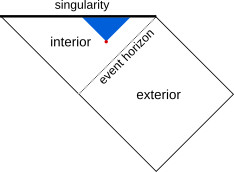I know that to a hypothetical observer infinitely far away from the black hole (sometimes known as the Schwarzchild observer), all in falling objects appear to "slow down and asymptotically freeze" at the event horizon.We can straight away guess this from the blowing up of the coefficient of the $dt^2$ term in the Schwarzchild metric and can show it in the case of a free in-falling object using this relation: $$dt=\int \frac{dr}{-c\left( 1 - \frac{r_{s}}{r} \right)\sqrt{1-\left( 1 - \frac{r_{s}}{r} \right) m^2c^2/E^2}}. $$
Where the symbols have their usual meanings. This basically says that the time required to cross the horizon is infinite because the denominator blows up at $r_s$.(we may show it for any other type of in-falling object too but this is a simple example).
What is the appropriate coordinate system that describes the situation from a free falling observer's point of view, what is the geodesic for a free in-falling object? At the horizon will it be visible one instant and invisible the next?

